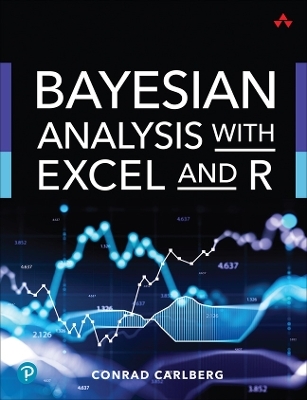
Bayesian Analysis with Excel and R
Addison Wesley (Verlag)
978-0-13-758098-9 (ISBN)
Bayesian methods can solve problems you can't reliably handle any other way. Building on your existing Excel analytics skills and experience, Microsoft Excel MVP Conrad Carlberg helps you make the most of Excel's Bayesian capabilities and move toward R to do even more.
Step by step, with real-world examples, Carlberg shows you how to use Bayesian analytics to solve a wide array of real problems. Carlberg clarifies terminology that often bewilders analysts, and offers sample R code to take advantage of the rethinking package in R and its gateway to Stan.
As you incorporate these Bayesian approaches into your analytical toolbox, you'll build a powerful competitive advantage for your organization—and yourself.
Explore key ideas and strategies that underlie Bayesian analysis
Distinguish prior, likelihood, and posterior distributions, and compare algorithms for driving sampling inputs
Use grid approximation to solve simple univariate problems, and understand its limits as parameters increase
Perform complex simulations and regressions with quadratic approximation and Richard McElreath's quap function
Manage text values as if they were numeric
Learn today's gold-standard Bayesian sampling technique: Markov Chain Monte Carlo (MCMC)
Use MCMC to optimize execution speed in high-complexity problems
Discover when frequentist methods fail and Bayesian methods are essential—and when to use both in tandem
Conrad Carlberg is a nationally recognized expert on quantitative analysis, data analysis, and management applications such as Microsoft Excel, SAS, and Oracle. He holds a Ph.D. in statistics from the University of Colorado and is a many-time recipient of Microsoft's Excel MVP designation. He is the author of many books, including Business Analysis with Microsoft Excel, Fifth Edition, Statistical Analysis: Microsoft Excel 2016, Regression Analysis Microsoft Excel, and R for Microsoft Excel Users. Carlberg is a Southern California native. After college he moved to Colorado, where he worked for a succession of startups and attended graduate school. He spent two years in the Middle East, teaching computer science and dodging surly camels. After finishing graduate school, Carlberg worked at US West (a Baby Bell) in product management and at Motorola. In 1995 he started a small consulting business (www.conradcarlberg.com), which provides design and analysis services to companies that want to guide their business decisions by means of quantitative analysis—approaches that today we group under the term “analytics.” He enjoys writing about those techniques and, in particular, how to carry them out using the world's most popular numeric analysis application, Microsoft Excel.
Preface
Chapter 1 Bayesian Analysis and R: An Overview
Bayes Comes Back
About Structuring Priors
Watching the Jargon
Priors, Likelihoods, and Posteriors
The Prior
The Likelihood
Contrasting a Frequentist Analysis with a Bayesian
The Frequentist Approach
The Bayesian Approach
Summary
Chapter 2 Generating Posterior Distributions with the Binomial Distribution
Understanding the Binomial Distribution
Understanding Some Related Functions
Working with R's Binomial Functions
Using R's dbinom Function
Using R's pbinom Function
Using R's qbinom Function
Using R's rbinom Function
Grappling with the Math
Summary
Chapter 3 Understanding the Beta Distribution
Establishing the Beta Distribution in Excel
Comparing the Beta Distribution with the Binomial Distribution
Decoding Excel's Help Documentation for BETA.DIST
Replicating the Analysis in R
Understanding dbeta
Understanding pbeta
Understanding qbeta
About Confidence Intervals
Applying qbeta to Confidence Intervals
Applying BETA.INV to Confidence Intervals
Summary
Chapter 4 Grid Approximation and the Beta Distribution
More on Grid Approximation
Setting the Prior
Using the Results of the Beta Function
Tracking the Shape and Location of the Distribution
Inventorying the Necessary Functions
Looking Behind the Curtains
Moving from the Underlying Formulas to the Functions
Comparing Built-in Functions with Underlying Formulas
Understanding Conjugate Priors
Summary
Chapter 5 Grid Approximation with Multiple Parameters
Setting the Stage
Global Options
Local Variables
Specifying the Order of Execution
Normal Curves, Mu and Sigma
Visualizing the Arrays
Combining Mu and Sigma
Putting the Data Together
Calculating the Probabilities
Folding in the Prior
Inventorying the Results
Viewing the Results from Different Perspectives
Summary
Chapter 6 Regression Using Bayesian Methods
Regression a la Bayes
Sample Regression Analysis
Matrix Algebra Methods
Understanding quap
Continuing the Code
A Full Example
Designing the Multiple Regression
Arranging a Bayesian Multiple Regression
Summary
Chapter 7 Handling Nominal Variables
Using Dummy Coding
Supplying Text Labels in Place of Codes
Comparing Group Means
Summary
Chapter 8 MCMC Sampling Methods
Quick Review of Bayesian Sampling
Grid Approximation
Quadratic Approximation
MCMC Gets Up To Speed
A Sample MCMC Analysis
ulam's Output
Validating the Results
Getting Trace Plot Charts
Summary and Concluding Thoughts
Appendix Installation Instructions for RStan and the rethinking Package on the Windows Platform
Glossary
Downloadable Bonus Content
Excel Worksheets
Book: Statistical Analysis: Microsoft Excel 2016 (PDF)
9780137580989 TOC 10/24/2022
| Erscheinungsdatum | 01.02.2022 |
|---|---|
| Verlagsort | Boston |
| Sprache | englisch |
| Maße | 176 x 230 mm |
| Gewicht | 319 g |
| Themenwelt | Informatik ► Datenbanken ► Data Warehouse / Data Mining |
| Informatik ► Office Programme ► Excel | |
| Wirtschaft ► Volkswirtschaftslehre ► Ökonometrie | |
| ISBN-10 | 0-13-758098-3 / 0137580983 |
| ISBN-13 | 978-0-13-758098-9 / 9780137580989 |
| Zustand | Neuware |
| Informationen gemäß Produktsicherheitsverordnung (GPSR) | |
| Haben Sie eine Frage zum Produkt? |
aus dem Bereich


